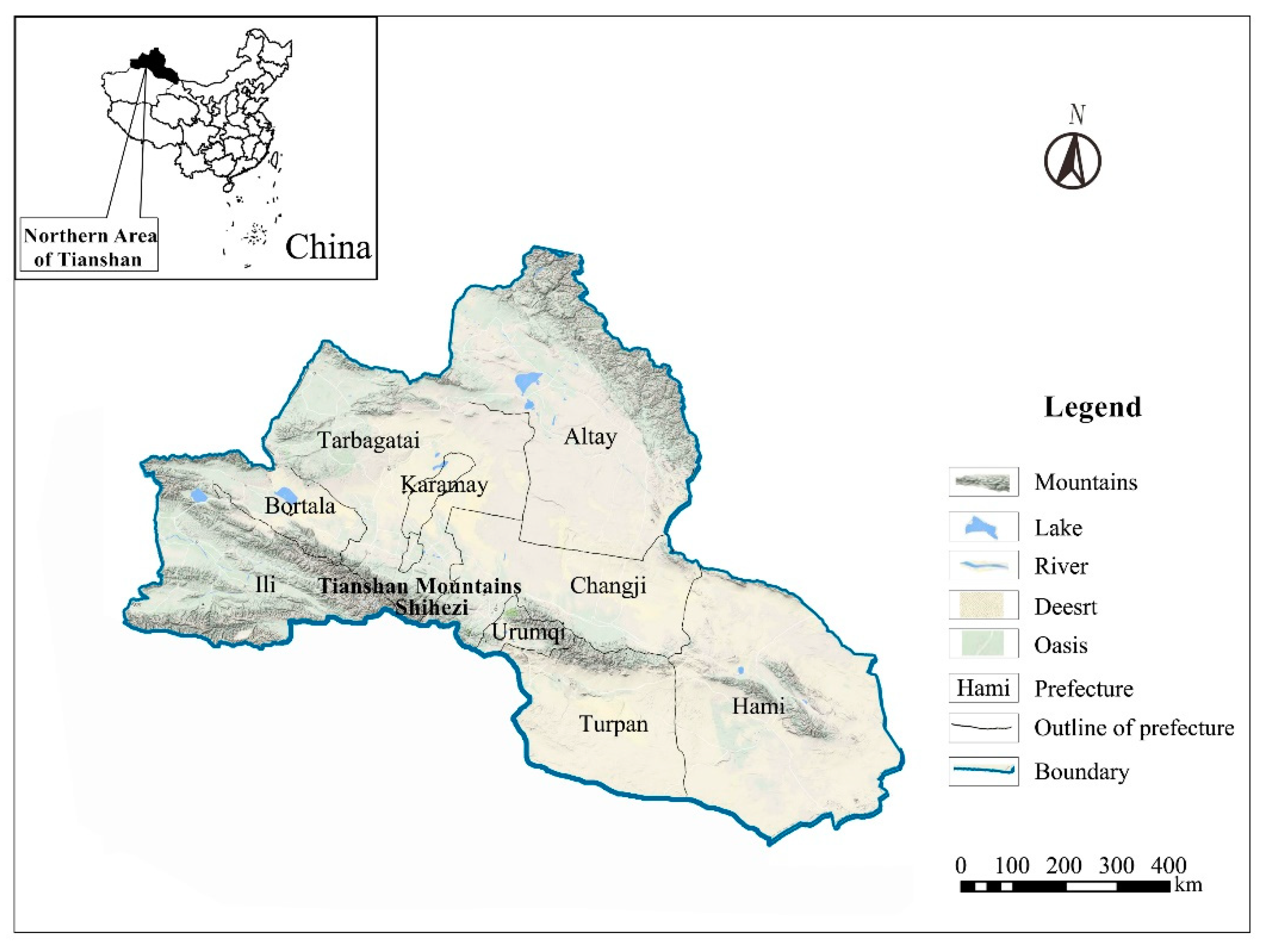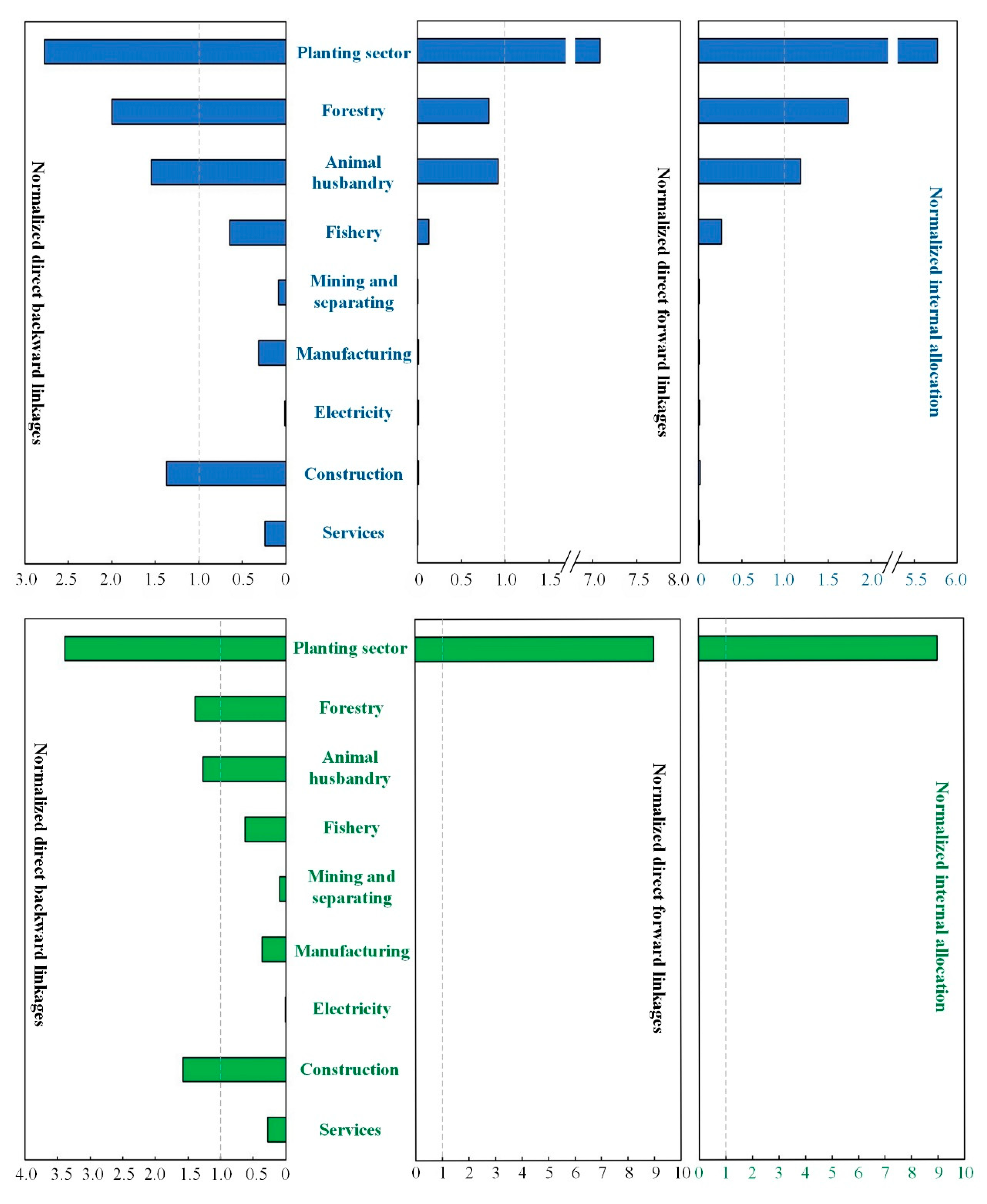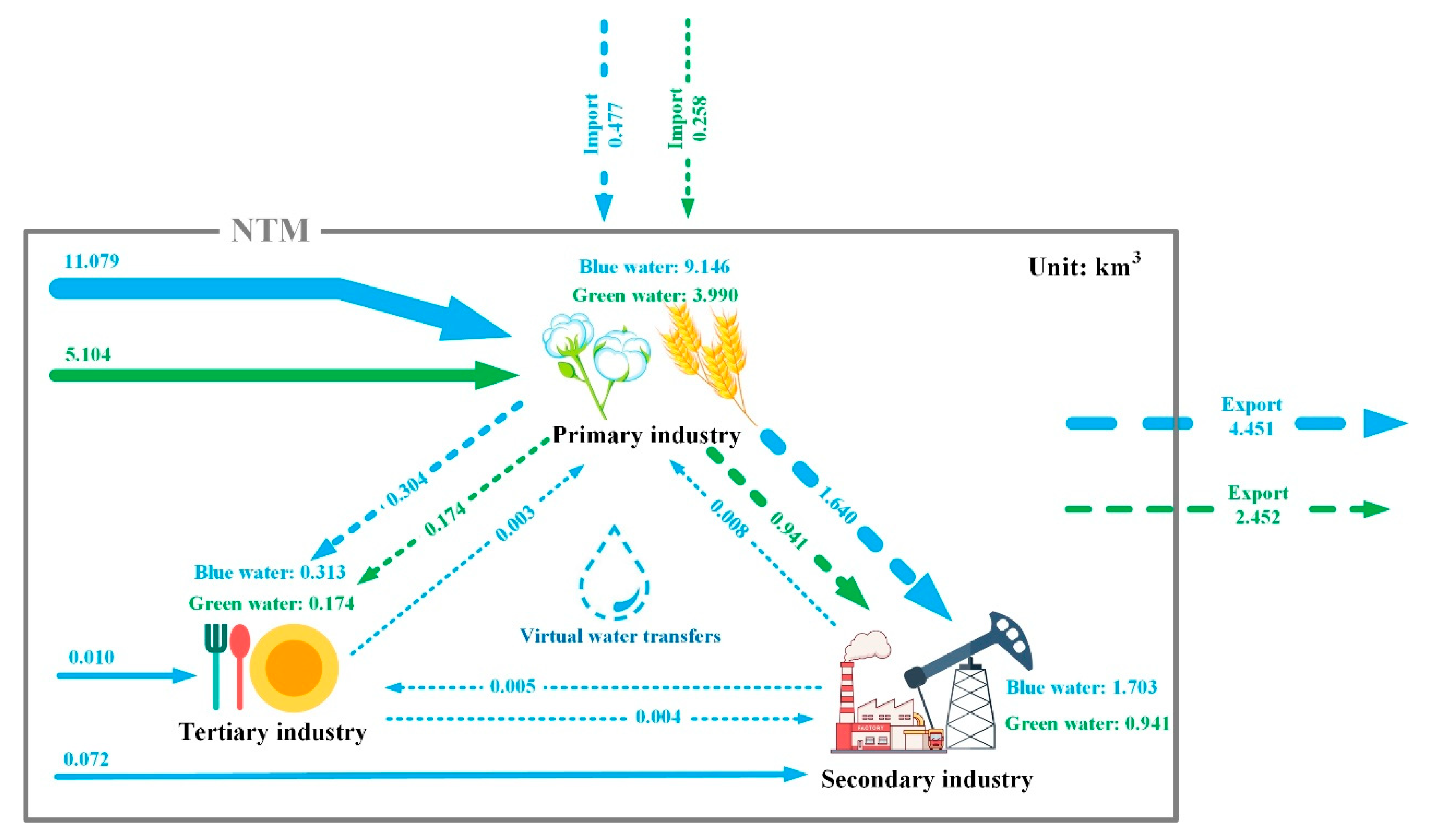Assessment of Inter-Sectoral Virtual Water Reallocation and Linkages in the Northern Tianshan Mountains, China
Abstract
1. Introduction
2. Methodology and Data
2.1. Study Area
2.2. Methodological and Empirical Framework
2.2.1. Update and Compilation Method of Input-Output Table
2.2.2. Virtual Water Reallocation Accounting Methods
2.2.3. Green Physical Water Consumption in Planting Sector
2.2.4. Backward and Forward Virtual Water Linkages
2.3. Data
3. Results
3.1. Internal Virtual Water Reallocation
3.2. Backward and Forward Linkages of Virtual Water
3.3. Inter-Industrial Flow, Import and Export of Virtual Water
4. Discussion
5. Conclusions
Supplementary Materials
Author Contributions
Funding
Acknowledgments
Conflicts of Interest
Appendix A
| Code | 42 Sectors in the Original IO Table | Aggregated 9 Sectors | Code | 42 Sectors in the Original IO Table | Aggregated 9 Sectors |
|---|---|---|---|---|---|
| 1 | Agriculture | Planting sector | 23 | Electricity, steam and hot water production and supply | Electricity |
| Forestry | 24 | Gas production and supply | |||
| Animal husbandry | 25 | Water production and supply | |||
| Fishery | 26 | Construction | Construction | ||
| 2 | Coal mining | Mining and separating | 27 | Transport, storage and post services | Services |
| 3 | Petroleum and natural gas extraction | 28 | Wholesale and retail trade services, | ||
| 4 | Metal ore mining | 29 | Accommodation and food serving services | ||
| 5 | Non-metal mining | Manufacturing | 30 | Information transfer and software engineering | |
| 6 | Manufacture of food products and tobacco processing | 31 | Information technology service | ||
| 7 | Textiles, Wearing apparel, leather, fur, down and related products | 32 | Finance | ||
| 8 | Sawmills and furniture | 33 | Real estate | ||
| 9 | Paper and products minerals, printing and record medium reproduction | 34 | Leasing and business service | ||
| 10 | Petroleum processing, coking and nuclear fuel processing | 35 | Scientific research and technical services | ||
| 11 | Chemical industry | 36 | Environmental and public facilities management | ||
| 12 | Nonmetallic mineral products | 37 | Resident service | ||
| 13 | Metal smelting, pressing and relatedproducts | 38 | Education services | ||
| 14 | General machinery | 39 | Health care and community service | ||
| 15 | Special purpose machinery | 40 | Facility repair service | ||
| 16 | Transport equipment | 41 | Public management and social security | ||
| 17 | Electric equipment and machinery | 42 | Culture, sports and entertainment | ||
| 18 | Electronic and telecommunication equipment | ||||
| 19 | Instruments and meters | ||||
| 20 | Other manufacturing products | ||||
| 21 | Scrap and waste | ||||
| 22 | Metal products, machinery and equipment repair services |
| Sectors | Planting Sector | Forestry | Animal Husbandry | Fishery | Mining and Separating | Manufacturing | Electricity | Construction | Services | Forward Linkages |
|---|---|---|---|---|---|---|---|---|---|---|
| Planting sector | 2.6694 | 1.0995 | 0.9992 | 0.4915 | 0.0755 | 0.2861 | 0.0050 | 1.2390 | 0.2177 | 7.0830 |
| Forestry | 0.0022 | 0.8041 | 0.0017 | 0.0019 | 0.0003 | 0.0008 | 0.0000 | 0.0038 | 0.0011 | 0.8160 |
| Animal husbandry | 0.1040 | 0.0872 | 0.5462 | 0.0288 | 0.0065 | 0.0249 | 0.0004 | 0.1063 | 0.0189 | 0.9233 |
| Fishery | 0.0002 | 0.0007 | 0.0002 | 0.1239 | 0.0001 | 0.0001 | 0.0000 | 0.0007 | 0.0003 | 0.1262 |
| Mining and separating | 0.0003 | 0.0007 | 0.0002 | 0.0001 | 0.0032 | 0.0002 | 0.0000 | 0.0014 | 0.0002 | 0.0062 |
| Manufacturing | 0.0010 | 0.0027 | 0.0008 | 0.0004 | 0.0002 | 0.0019 | 0.0000 | 0.0037 | 0.0006 | 0.0114 |
| Electricity | 0.0008 | 0.0021 | 0.0006 | 0.0003 | 0.0004 | 0.0005 | 0.0043 | 0.0034 | 0.0006 | 0.0130 |
| Construction | 0.0008 | 0.0022 | 0.0006 | 0.0003 | 0.0002 | 0.0004 | 0.0000 | 0.0087 | 0.0009 | 0.0142 |
| Services | 0.0005 | 0.0018 | 0.0004 | 0.0002 | 0.0002 | 0.0003 | 0.0000 | 0.0018 | 0.0015 | 0.0067 |
| Backward linkages | 2.7793 | 2.0009 | 1.5501 | 0.6475 | 0.0866 | 0.3151 | 0.0098 | 1.3689 | 0.2418 | 9.0000 |
| Sectors | Planting Sector | Forestry | Animal Husbandry | Fishery | Mining and Separating | Manufacturing | Electricity | Construction | Services | Forward Linkages |
|---|---|---|---|---|---|---|---|---|---|---|
| Planting sector | 3.3919 | 1.3971 | 1.2696 | 0.6246 | 0.0959 | 0.3636 | 0.0064 | 1.5743 | 0.2767 | 9.0000 |
| Forestry | 0.0000 | 0.0000 | 0.0000 | 0.0000 | 0.0000 | 0.0000 | 0.0000 | 0.0000 | 0.0000 | 0.0000 |
| Animal husbandry | 0.0000 | 0.0000 | 0.0000 | 0.0000 | 0.0000 | 0.0000 | 0.0000 | 0.0000 | 0.0000 | 0.0000 |
| Fishery | 0.0000 | 0.0000 | 0.0000 | 0.0000 | 0.0000 | 0.0000 | 0.0000 | 0.0000 | 0.0000 | 0.0000 |
| Mining and separating | 0.0000 | 0.0000 | 0.0000 | 0.0000 | 0.0000 | 0.0000 | 0.0000 | 0.0000 | 0.0000 | 0.0000 |
| Manufacturing | 0.0000 | 0.0000 | 0.0000 | 0.0000 | 0.0000 | 0.0000 | 0.0000 | 0.0000 | 0.0000 | 0.0000 |
| Electricity | 0.0000 | 0.0000 | 0.0000 | 0.0000 | 0.0000 | 0.0000 | 0.0000 | 0.0000 | 0.0000 | 0.0000 |
| Construction | 0.0000 | 0.0000 | 0.0000 | 0.0000 | 0.0000 | 0.0000 | 0.0000 | 0.0000 | 0.0000 | 0.0000 |
| Services | 0.0000 | 0.0000 | 0.0000 | 0.0000 | 0.0000 | 0.0000 | 0.0000 | 0.0000 | 0.0000 | 0.0000 |
| Backward linkages | 3.3919 | 1.3971 | 1.2696 | 0.6246 | 0.0959 | 0.3636 | 0.0064 | 1.5743 | 0.2767 | 9.0000 |
References
- Mekonnen, M.M.; Hoekstra, A.Y. Four billion people facing severe water scarcity. Sci. Adv. 2016, 2, e1500323. [Google Scholar] [CrossRef] [PubMed]
- Jiang, Y. China’s water scarcity. J. Environ. Manag. 2009, 90, 3185–3196. [Google Scholar] [CrossRef] [PubMed]
- Allan, J.A. Fortunately there are substitutes for water otherwise our hydro-political futures would be impossible. Prior. Water Resour. Alloc. Manag. 1993, 13, 26. [Google Scholar]
- Cai, B.; Zhang, W.; Hubacek, K.; Feng, K.; Li, Z.; Liu, Y. Drivers of virtual water flows on regional water scarcity in China. J. Clean. Prod. 2019, 207, 1112–1122. [Google Scholar] [CrossRef]
- Dalin, C.; Konar, M.; Hanasaki, N.; Rinaldo, A.; Rodriguez-lturbe, L. Evolution of the global virtual water trade network. Proc. Natl. Acad. Sci. USA 2012, 109, 5989–5994. [Google Scholar] [CrossRef]
- Ministry of Science and Technology, PRC. 13th Five-Year Special Plan on Scientific and Technological Innovation in Resource Areas. Available online: http://www.most.gov.cn/mostinfo/xinxifenlei/fgzc/gfxwj/gfxwj2017/201705/t20170517_132852.htm/ (accessed on 15 April 2019).
- Jewitt, G.P. Integrating blue and green water flows for water resources management and planning. Phys. Chem. Earth 2006, 31, 753–762. [Google Scholar] [CrossRef]
- Rockstrom, J.; Falkenmark, M.; Karlberg, L.; Hoff, H.; Rost, S.; Gerten, D. Future water availability for global food production: The potential of green water for increasing resilience to global change. Water Resour. Res. 2009, 45, W00A12. [Google Scholar] [CrossRef]
- Sun, S.; Wu, P.; Wang, Y.; Zhao, X. The virtual water content of major grain crops and virtual water flows between regions in China. J. Sci. Food Agric. 2013, 93, 1427–1437. [Google Scholar] [CrossRef]
- Aldaya, M.M.; Allan, J.A.; Hoekstra, A.Y. Strategic importance of green water in international crop trade. Ecol. Econ. 2010, 69, 887–894. [Google Scholar] [CrossRef]
- Yang, Z.F.; Zhi, Y.; Yin, X.A. Research advances in virtual water. Adv. Sci. Technol. Water Resour. 2015, 35, 181–190. (In Chinese) [Google Scholar]
- Qasemipour, E.; Abbasi, A. Assessment of agricultural water resources sustainability in arid regions using virtual water concept: Case of South Khorasan Province, Iran. Water 2019, 11, 449. [Google Scholar] [CrossRef]
- Zhao, X.; Tillotson, M.; Yang, Z.F.; Yang, H.; Liu, J.G. Reduction and reallocation of water use of products in Beijing. Ecol. Indic. 2016, 61, 893–898. [Google Scholar] [CrossRef]
- Zhang, X.X.; Liu, J.G.; Zhao, X.; Yang, H.; Deng, X.; Jiang, X.; Li, Y. Linking physical water consumption with virtual water consumption: Methodology, application and implications. J. Clean. Prod. 2019, 228, 1206–1217. [Google Scholar] [CrossRef]
- Yu, Y.; Hubacek, K.; Feng, K.; Guan, D. Assessing regional and global water footprints for the UK. Ecol. Econ. 2010, 69, 1140–1147. [Google Scholar] [CrossRef]
- Zhang, X.X.; Liu, J.G.; Zhao, X.; Guan, Y. Virtual water transfer and linkages among industries in the Heihe River basin. Arid Zone Res. 2018, 35, 27–34. (In Chinese) [Google Scholar]
- Chen, Y.N.; Li, B.F.; Li, Z.; Li, W.H. Water resource formation and conversion and water security in arid region of Northwest China. J. Geogr. Sci. 2016, 26, 939–952. [Google Scholar] [CrossRef]
- Lahr, M.; de Mesnard, L. Biproportional techniques in input-output analysis: Table updating and structural analysis. Econ. Syst. Res. 2004, 16, 115–134. [Google Scholar] [CrossRef]
- McMenamin, G.; Haring, J. An appraisal of non-survey techniques for estimating regional input-output models. J. Region. Sci. 1974, 14, 191–205. [Google Scholar] [CrossRef]
- Fritz, O.; Kurzmann, R.; Zakarias, G.; Streicher, G. Constructing regional input-output tables for Austria. Austrian Econ. Quart. 2003, 8, 23–39. [Google Scholar]
- Almazán-Gómez, M.A.; Duarte, R.; Langarita, R.; Sánchez-Chóliz, J. Effects of water reallocation in the Ebro river basin: A multiregional input-output and geographical analysis. J. Environ. Manag. 2019, 241, 645–657. [Google Scholar] [CrossRef]
- Liu, W.D. The Theory and Practice of Compiling Input-Output Tables for 30 Provinces and Autonomous Regions in China in 2007; China Statistics Press: Beijing, China, 2012. (In Chinese) [Google Scholar]
- Miller, R.E.; Blair, P.D. Input-Output Analysis: Foundations and Extensions; Cambridge University Press: Cambridge, UK, 2009. [Google Scholar]
- Berners-Lee, M.; Howard, D.C.; Moss, J.; Kaivanto, K.; Scott, W.A. Greenhouse gas foot printing for small businesses—The use of input-output data. Sci. Total Environ. 2011, 409, 883–891. [Google Scholar] [CrossRef] [PubMed]
- Chen, X.; Guo, J. Empirical analysis on the measurement, evaluation and influencing factors of virtual water trade in China—Based on the input-output formula and SDA model. Mod. Financ. Econ. 2017, 37, 101–113. (In Chinese) [Google Scholar]
- Surendran, U.; Sushanth, C.M.; Joseph, E.J.; Nadhir, A. FAO CROPWAT Model-Based irrigation requirements for coconut to improve crop and water productivity in Kerala, India. Sustainability 2019, 11, 5132. [Google Scholar] [CrossRef]
- Stancalie, G.; Marica, A.; Toulios, L. Using earth observation data and CROPWAT model to estimate the actual crop evapotranspiration. Phys. Chem. Earth 2010, 35, 25–30. [Google Scholar] [CrossRef]
- Tan, M.; Zheng, L. Increase in economic efficiency of water use caused by crop structure adjustment in arid areas. J. Environ. Manag. 2019, 230, 386–391. [Google Scholar] [CrossRef] [PubMed]
- Michael, J.; Lathuillière, M.T.; Johnson, M.S. What could irrigated agriculture mean for Amazonia? A review of green and blue water resources and their trade-offs for future agricultural production in the Amazon Basin. Hydrol. Earth Syst. Sci. 2016, 20, 2179. [Google Scholar]
- Eduardo, V.; Alberto, V.; Samantha, R.Y.; Angela, M.A.; María, G.S.; Hassane, M.; Esteban, C.; Antonio, D.C.; Juan, B. Water balance of mediterranean quercus ilex L. and pinus halepensis mill. forests in semiarid climates: A review in a climate change context. Forests 2018, 9, 426. [Google Scholar]
- Chen, G.; Hadjikakou, M.; Wiedmann, T. Urban carbon transformations: Unravelling spatial and inter-sectoral linkages for key city industries based on multi-region input-output analysis. J. Clean. Prod. 2017, 163, 224–240. [Google Scholar] [CrossRef]
- Akkoyunlu, S. The potential of rural-urban linkages for sustainable development and trade. Int. J. Sustain. Dev. World Policy 2015, 4, 20–40. [Google Scholar] [CrossRef]
- Mukhopadhyay, K. Applications of the Input-Output Framework; Springer: New York, NY, USA, 2018. [Google Scholar]
- Xinjiang Uygur Autonomous Region Statistics Bureau. Xinjiang Statistical Yearbook; China Statistics Press: Beijing, China, 1989–2016. (In Chinese)
- Ashraf, S.; AghaKouchak, A.; Nazemi, A.; Mirchi, A.; Sadegh, M.; Hassanzadeh, H.; Miao, C.; Madani, K.; Mohammad, M.; Anjileli, H.; et al. Compounding effects of human activities and climatic changes on surface water availability in Iran. Clim. Chang. 2019, 152, 379–391. [Google Scholar] [CrossRef]
- Sesma-Martín, D. Cooling water: A source of conflict in Spain, 1970–1980. Sustainability 2020, 12, 4650. [Google Scholar] [CrossRef]
- Delbourg, E.; Dinar, S. The globalization of virtual water flows: Explaining trade patterns of a scarce resource. World Dev. 2020, 131, 104917. [Google Scholar] [CrossRef]
- Zhao, X.; Tillotson, M.R.; Liu, Y.W.; Guo, W.; Yang, A.H.; Li, Y.F. Index decomposition analysis of urban crop water footprint. Ecol. Modell. 2017, 348, 25–32. [Google Scholar] [CrossRef]
- Zhuo, L.; Mekonnen, M.; Hoekstra, A.Y. The effect of inter-annual variability of consumption, production, trade and climate on crop-related green and blue water footprints and inter-regional virtual water trade: A study for China (1978–2008). Water Res. 2016, 94, 73–85. [Google Scholar] [CrossRef]
- Zhao, R.; Chen, Y.; Shi, P.; Zhang, L.; Pan, J.; Zhao, H. Land use and land cover change and driving mechanism in the arid inland river basin: A case study of Tarim River, Xinjiang, China. Environ. Earth Sci. 2013, 68, 591–604. [Google Scholar] [CrossRef]
- Zhang, P.; Deng, X.Y.; Long, A.H.; Hai, Y.; Li, Y.; Wang, H.; Xu, H.L. Impact of social factors in agricultural production on the crop water footprint in Xinjiang, China. Water 2018, 10, 1145. [Google Scholar] [CrossRef]





| Industry | Primary Industry | Secondary Industry | Tertiary Industry | PW Consumption | Internal Distribution | |
|---|---|---|---|---|---|---|
| Blue water | Primary industry | 9.135 | 1.640 | 0.304 | 11.079 | 9.135 |
| Secondary industry | 0.008 | 0.059 | 0.005 | 0.072 | 0.059 | |
| Tertiary industry | 0.003 | 0.004 | 0.003 | 0.010 | 0.003 | |
| VW consumption | 9.146 | 1.703 | 0.313 | 11.162 | 9.197 | |
| Green water | Primary industry | 3.990 | 0.941 | 0.174 | 5.104 | 3.990 |
| Secondary industry | 0.000 | 0.000 | 0.000 | 0.000 | 0.000 | |
| Tertiary industry | 0.000 | 0.000 | 0.000 | 0.000 | 0.000 | |
| VW consumption | 3.990 | 0.941 | 0.174 | 5.104 | 3.990 | |
| Sectors | Planting Sector | Forestry | Animal Husbandry | Fishery | Mining and Separating | Manufacturing | Electricity | Construction | Services |
|---|---|---|---|---|---|---|---|---|---|
| Blue water | 3.128 | 0.031 | 0.619 | 0.006 | 0.158 | −0.041 | 0.018 | −0.011 | 0.067 |
| Green water | 1.905 | 0.007 | 0.182 | 0.002 | 0.083 | −0.023 | 0.009 | −0.006 | 0.037 |
© 2020 by the authors. Licensee MDPI, Basel, Switzerland. This article is an open access article distributed under the terms and conditions of the Creative Commons Attribution (CC BY) license (http://creativecommons.org/licenses/by/4.0/).
Share and Cite
Gao, D.; Long, A.; Yu, J.; Xu, H.; Su, S.; Zhao, X. Assessment of Inter-Sectoral Virtual Water Reallocation and Linkages in the Northern Tianshan Mountains, China. Water 2020, 12, 2363. https://doi.org/10.3390/w12092363
Gao D, Long A, Yu J, Xu H, Su S, Zhao X. Assessment of Inter-Sectoral Virtual Water Reallocation and Linkages in the Northern Tianshan Mountains, China. Water. 2020; 12(9):2363. https://doi.org/10.3390/w12092363
Chicago/Turabian StyleGao, Dedao, Aihua Long, Jiawen Yu, Helian Xu, Shoujuan Su, and Xu Zhao. 2020. "Assessment of Inter-Sectoral Virtual Water Reallocation and Linkages in the Northern Tianshan Mountains, China" Water 12, no. 9: 2363. https://doi.org/10.3390/w12092363
APA StyleGao, D., Long, A., Yu, J., Xu, H., Su, S., & Zhao, X. (2020). Assessment of Inter-Sectoral Virtual Water Reallocation and Linkages in the Northern Tianshan Mountains, China. Water, 12(9), 2363. https://doi.org/10.3390/w12092363





